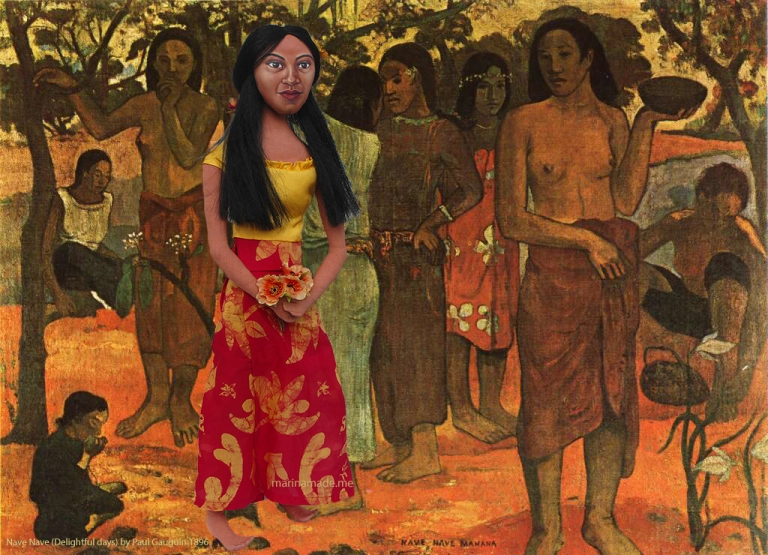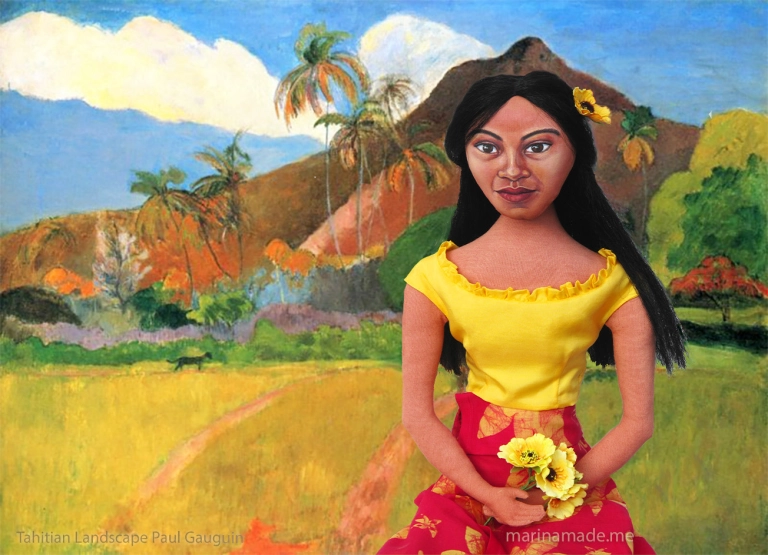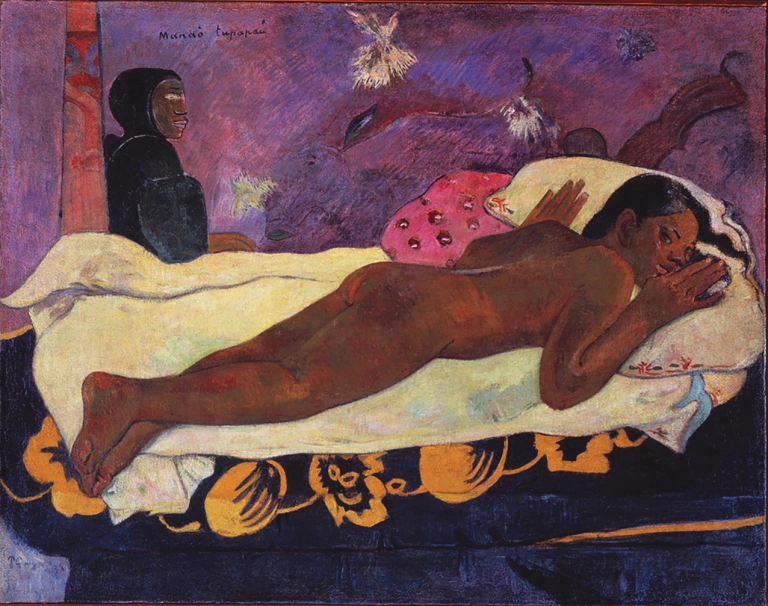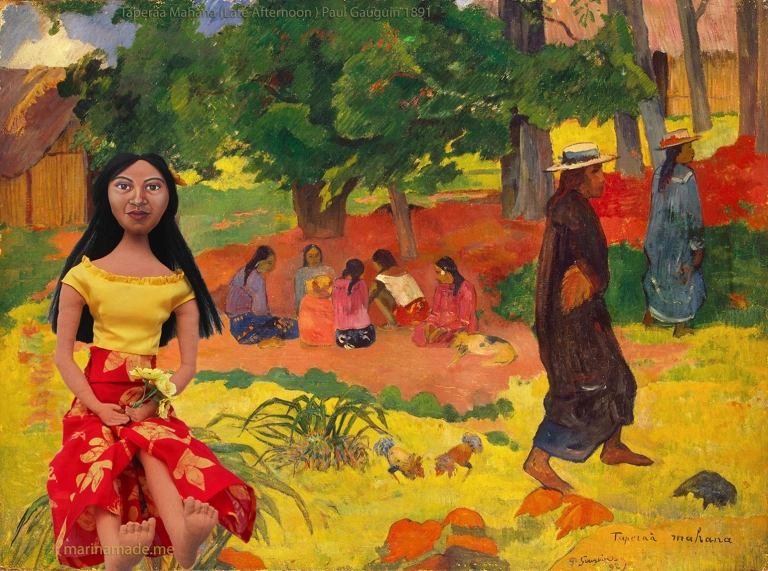Teha’amana muse

Teha’amana was Gauguin’s first Tahitian muse and lover, becoming his native wife at only thirteen. This was however considered a marriageable age within Tahitian culture at that time.

Much has been written about Gauguin’s life in Tahiti, these express split opinions and have shocked the sensibilities and morals of todays standards. I find Gauguin’s story fascinating and disturbing in equal measures but there is no doubt that his experimental, uniquely coloured, “primitive” style of painting influenced the path of Modern art. Picasso and Matisse were certainly inspired by his bold approach to form and colour; and possibly his life style.

Gauguin was not the first artistic voyager to be inspired by the colonised world, but he is probably one of the most well known. He had made several attempts to find a tropical paradise, where he could “live on fish and fruit” and paint in his own experimental style; travelling to Martinique and Madagascar before choosing Tahiti as his “Studio of the Tropics”.
Teha’amana, Gauguin’s muse
Teha’amana was the native wife of Paul Gauguin during his first visit to Tahiti in 1891 to 1893. At that time it was common for French colonists to take native wives, who were referred to as vahine, Tahitian for “woman”. These vahines were often very young, some just having reached puberty as had Teha’amana. Their marriage would be arranged by their family for reasons of status or financial advantage. The daughters concerned usually entered such marriages willingly, with them generally being non-binding, and the girl free to return home at any time. Teha’amana no doubt saw herself as conventionally married according to her local customs, but for Gauguin the marriage was clearly a temporary arrangement, for his comfort and domestic convenience.

For Gauguin having a vahine brought practical advantages and a regular supply of food. Tahitian families were self sufficient; they fished, hunted wild pigs and gathered breadfruit and bananas from the mountains, consequently there was no trade in foodstuffs. Gauguin had no time to do this for himself as he wanted to paint, so this was a perfect arrangement for him.
Teha’amana means “giver of strength” and appears in ancient prayers and folklore. This appealed to Gauguin, who described how in the evenings when they were in bed, Teha’amana would recount their ancient myths. Unfortunately this is unlikely to be true as Teha’amana was a Christian and these myths had always been withheld from women.
Teha’amana’s family came from Rarotonga, one of the Cook Islands. they settled in Tahiti after their daughter was born in Fa’aone, fifteen miles away from Gauguin’s bamboo hut in Mataiea. Gauguin encountered the family in 1891 at the end of his first year in Tahiti and he took Teha’amana as his vahine the same afternoon. There was no birth certificate, but it is thought that she was in her early teens. By August the following year she was pregnant, but there is no record of the child. It was the custom for children to be fostered or adopted in Tahitian society, which is thought to be the case with Teha’amana’s baby.

After Gauguin left for Paris in 1893 and a tearful farewell, Teha’amana remained in Mataiea, working for Chief Tetuanui, but it was not long before she married a young Tahitian boy, named Ma’ari, from Papara and bore him two sons.
On Gauguin’s return in 1895, Teha’amana was married to Ma’ari, but regardless she spent a week with him before returning to her husband. Teha’amana was repulsed by Gauguin’s syphilitic sores (which covered his entire body) and declined to live with him despite generous gifts of bead necklaces and brass rings.
After Gaugin’s death Teha’amana made no attempt to come forward as his vahine, it seemed that she was indifferent to his memory. Teha’amana died fairly young on 9th December 1918 in Mataiea from the Spanish flu epidemic that carried off a quarter of Tahiti’s native population.

Gauguin in Tahiti
Gauguin had been a Paris stockbroker, seeming every bit the upstanding member of the Parisian bourgeoisie and painting only in his spare time.Yet in 1883, with five children to support, he resigned from his job and decided to pursue an artistic career.
In the late 1880s Gauguin became disenchanted with Paris, he was frustrated by the lack of recognition and had become financially destitute. He made a plan to sail to the tropics to escape European civilisation and “everything that is artificial and conventional.” Nevertheless he took care to take with him a collection of visual stimuli in the form of drawings, prints and photographs.
He visited his wife and children, for what turned out to be the last time, promising to return a rich man and make a fresh start.
In 1891, Gauguin sailed to Tahiti, the island he imagined to be a primitive paradise; but when he arrived in Papeete, the capital of the colony, he was disappointed to find that European missionaries had been at work for a long time before he got there and so, instead of luscious young Tahitian girls, he found women dressed in smocks with high necked white collars, attending church every Sunday.
After three months he decided to set up his studio forty-five kilometres away in Mataiea, Papeari a small coastal village in the south, said to be Tahiti’s oldest village. He set himself up in a native-style bamboo hut and started painting the local women while busy with their simple daily tasks. The old Tahiti was a more powerful vision for him.

Living in Mataiea Village, Gauguin began making paintings of Tahitian life as he imagined it, a rustic idyll largely lacking the presence of modern-day elements and the Christian missionaries. There were several Tahitian girls who were Gauguin’s muses during his time there. They were Teha’amana, Pahura, Tohotaua and Marie- Rose Vaeoho.
They weren’t always as obedient as he wished and would leave him when they desired, but the relationships were aligned in his favour, to a man comfortable with his colonial privileges .
Gauguin expected his muses to meet all his needs; sexual, aesthetic and domestic, while remaining pliant and undemanding of him. It was a relationship that was exploitative, yet these girls associated themselves with him with some eagerness. Their parents were quite willing for their daughters to spend time in his company, as it was customary for girls to be married off soon after puberty.
Within a year he met the young, beautiful Teha’amana, whom he swiftly recruited as his model, muse, and lover for the next two years. Gauguin described his muse as his ” little mistress with instinctive ways and a golden body, docile and loving”.

While Gauguin did not officially marry Teha’amana, he took her as a native wife; vows of a sort were exchanged and a marriage was contracted. She was aged thirteen and he was forty-three. Their ability to enjoy anything like a marriage was extremely limited, they couldn’t even speak the same language and with Teha’amana being so young, it was not an equal relationship. She was pregnant by the end of the summer.
She was painted in a number of works, most famously in “Manao Tupapau” or ‘Spirit of the Dead Watching’. When the painting was exhibited in 1893 it was dubbed the “brown Olympia”. Like Manet’s Olympia of 1863, Teha’amana was pubescent, but more shocking was the overt suggestion that both young women were sexually experienced.

Gauguin came to see the women of Tahiti as not only emblematic of the island itself, and the island’s culture, but as the embodiments of a certain sort of feminine grace. The “naturalness” of the Polynesian women in contrast to what he took to be the falsity of women of his own class in Europe.
He found himself inspired by Tahiti’s tropical flora and fauna, and its fast-disappearing Maori culture, ritual and myths, which he felt compelled to capture on canvas. However rather than capturing the reality of what he saw in the region, Gauguin preferred to portray a deeply exoticized Tahiti, drawn out from a colonial master’s imagination, reinforcing stereotypical portraits of the island.
Gauguin was not naïve; his Polynesian Eden was a concept, more an ideal for the primitive than a reality. He wavered between regretful awareness that his Eden was a myth and a stubborn insistence on its existence.

At this time, he was still married to his wife Mette Sophie Gad, sending her batches of paintings from Tahiti to exhibit in Copenhagen, where she was living with their children.
In 1894 Gauguin returned to Paris to exhibit his paintings at the Durand-Ruel Gallery, which was a moderate success. He stayed for two years, living as a flamboyant character in the artist district of Montparnasse. He had a public affair with a teenage Malayan girl, known as ‘Annah the Javanese’, who had his baby and brought the child up on her own. By this time it was clear that he and his wife were irrevocably separated. His failure to take Paris by storm in this period lead to more disenchantment and a longing to return to his Eden, Tahiti.

Upon Gauguin’s departure for Paris, Teha’amana married a local man, and then refused to move back in with Gauguin upon his return, due to his syphilitic sores. (It is thought that he arrived in Tahiti with Syphilis in 1891, which worsened over his time there. He probably infected several of his muses.)
On his return to Tahiti, Gauguin moved on to at least two other indigenous Polynesian girls and had sexual relationships with a number of the models who posed for him. Two of these subsequently bore his children. This he justified by saying that Tahiti always welcomed the birth of children, that they were something to be celebrated.
Increasingly disgusted with the rising Western influence in the French colony, which he saw as the “corruption of Oceania”, Gauguin again sought a more remote environment, this time on the island of Hiva Oa in the Marquesas, where he moved in September 1901. He purchased land there and with the help of his neighbours, he built a home that he called “The house of pleasure.”
It was here that he set up home with his last “wife”, fourteen year old Marie-Rose Vaeoho.



Gauguin instinctively sided with the native people, despite being European. He often clashed with the colonial authorities and with the Catholic Church.
In 1903, he had a public disagreement with the Church and government which earned him a three-month prison sentence and a fine. However before he could begin his jail term he died of syphilis at the age of 54, his body broken by many years of drunken and sexual dissipation.
He perished in this paradise as a lonely and sick man without a family, or friends and oblivious to the enormity of his legacy to the art world.


Other 20th Century muses by Marina
Jeanne Hébuterne Modigliani’s muse
Lydia Delectorskaya Matisse’ muse
Marie-Thérèse Walter Picasso’s muse
Emilie Flöge Klimt’s muse
Frida Kahlo muse
Dora Maar
Wally Neuzil
Acknowledgements
Patty O’Brien, Pacific Muse: Exotic Femininity and the Colonial Pacific
Arifa Akbar, Gaugin: The painter who invented his own brand of artistic licence
Elizabeth C. Childs, Vanishing Paradise: Art and Exoticism in Colonial Tahiti
ArtLark, The Story Behind Gauguin’s Biographic Noa Noa




















Thanks for your comment, I appreciate any further research on my subjects. I don’t think I stated that Teha’ amana lived and had children. At the time of my research there was no birth or death certificate.
LikeLike
So fascinating to see your soft sculpture work. I have just watched Vincent Cassell playing Gauguin and came upon your work while searching for his paintings. Thank you for putting such an interesting and unusual spin on the works.
LikeLike
Thank you Syl, it is a project I have been brewing for a long time but have only recently had the time to devote the hours to it. The collection is slowly growing, each muse takes several weeks, and then the research/writing take just as long, but I feel the need to tell their story as accurately as possible.
LikeLike
Thank you for your feedback Barbara, I enjoyed the research, there is a lot to read and very contrasting views, but incredibly interesting. I have only touched the subject of Gauguin’s muses and his legacy, but there is much more in depth historical literature out there.
The images take some time to do using Photoshop, but they have become part of the project. I wasn’t sure if my muse Teha’ amana would work against Gauguin’s colours and solid figures, but I have been happy with most of the images.
I hope it warms up for you soon, it is stormy here in Sussex.
I am glad you appretiate what I am doing, many thanks,
Marina
LikeLike
Thank you so much for this in-depth research on Gaugin, Marina. I had no idea he had so many muses, not to mention illegitimate children! What a cad he was, but then he left us the exotic legacy of his colourful life on canvas which, as you say, influenced, and still influences, everything that followed. I love the way you place your creations in your artists’ works, getting the scale and perspective so correct that we’re seduced into believing they’re part of the original painting. That takes some doing! Extremely well done Marina. You must exhibit this work! Best wishes from a small apartment in Nerja by the stormy Mediterranean where we’re supposed to be escaping a cold south of France! You have certainly brightened up my day! Thanks again, Barbara
Sent from my iPad
>
LikeLike
Just brilliant Marina, what more can I say.
LikeLiked by 1 person